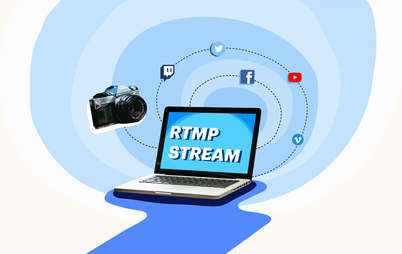In 2024, live streaming has become more than just a hobby—it’s a global phenomenon that attracts millions of viewers daily. Gamers, in particular, have embraced this trend, using live streaming platforms to showcase their skills, connect with audiences, and even earn a living. But with so many platforms available, choosing the right one can be overwhelming. In this article, we’ll explore the top 7 gaming streaming platforms of 2024, compare their features, and help you decide which one is best suited for your needs.
7 Most Popular Streaming Platforms for Gaming
Twitch
Twitch, launched in 2011 and acquired by Amazon in 2014, has grown into the most dominant live streaming platform for gaming. With millions of active streamers and viewers daily, Twitch offers a variety of content ranging from live gameplay to esports, music, and creative content. The platform has a robust infrastructure with support for high-quality streams, interactive features like chat, and a dedicated community that can help streamers build their following. Twitch’s integration with Amazon Prime also allows for unique benefits like Prime Gaming, which can attract more viewers.
Pros:
- Twitch’s massive user base gives streamers access to a global audience.
- Streamers can earn through subscriptions, Bits (Twitch’s virtual currency), ads, and donations.
- Emotes, channel points, and raids foster a strong sense of community.
- Extensive support for streaming software, bots, and tools.
Cons:
- The platform is saturated, making it hard for new streamers to stand out.
- Twitch has strict content and community guidelines, with the risk of account bans for violations.
- Twitch takes a 50% cut of subscription revenue, which some streamers feel is too high.
YouTube Gaming
YouTube Gaming is an extension of YouTube, focusing specifically on gaming content, including live streams, VODs (videos on demand), and community interactions. Since its launch in 2015, it has become a significant player in the game streaming market. YouTube Gaming benefits from being part of the broader YouTube ecosystem, where streams can easily be discovered by the platform’s 2 billion monthly active users. The integration with Google’s services and its powerful search engine gives streamers a unique advantage in terms of discoverability and SEO. Streams are automatically archived as videos, which can continue to generate views long after the live event is over.
Pros:
- Access to YouTube’s massive, global audience, which can help in growing your channel.
- Streams are automatically saved as videos, offering long-term viewership potential.
- Multiple ways to earn, including ad revenue, Super Chats, channel memberships, and sponsorships.
- YouTube’s algorithm and search engine can help new viewers find your content.
Cons:
- While it’s great for content variety, the broader focus can make it harder to attract a purely gaming audience.
- YouTube’s community features aren’t as engaging as Twitch’s, with less emphasis on live interaction.
- Strict ad policies can limit monetization, particularly for gaming content that might not be “advertiser-friendly.”
Facebook Gaming
Launched as a gaming hub within Facebook, Facebook Gaming has quickly grown to become a significant player in the live streaming space. The platform leverages Facebook’s vast social network, making it easy for streamers to share their content with friends, followers, and specific groups. Facebook Gaming also offers several unique features, such as instant games and game discovery, that integrate seamlessly with the broader Facebook ecosystem. The platform supports both desktop and mobile streaming, making it accessible to a wide audience. Additionally, Facebook’s targeted advertising tools can help streamers reach specific demographics.
Pros:
- Streamers can easily share their streams across Facebook’s social network, increasing visibility.
- Streamers can earn through Facebook Stars (a virtual currency), fan subscriptions, and in-stream ads.
- Includes tools like polls, quizzes, and live reactions, which enhance viewer engagement.
- Streams can be integrated into the broader Facebook ecosystem, including feeds, groups, and pages.
Cons:
- While Facebook is huge, the dedicated gaming audience is smaller compared to Twitch or YouTube.
- Streams are often connected to personal profiles, which can be a privacy concern.
- Compared to Twitch, Facebook has fewer third-party integrations and advanced streaming tools.
Trovo
Trovo, launched in 2020 and backed by Tencent, is a live streaming platform similar to Twitch but with a focus on community building and viewer rewards. It offers a familiar interface to Twitch users but distinguishes itself with programs like Trovo 500, which rewards streamers based on performance metrics. Trovo is particularly appealing to newer streamers looking for a platform with lower competition and a chance to build a community from the ground up. It supports both PC and mobile streaming and has been growing steadily, particularly in regions where Tencent has a strong presence.
Pros:
- As a newer platform, Trovo has less competition, making it easier for new streamers to gain traction.
- Trovo emphasizes community interaction through features like Trovo Play and the Trovo 500 program, which rewards streamers based on their performance.
- Streamers can earn through subscriptions, spell gifting (a type of virtual currency), and engagement rewards.
- Trovo is highly accessible for both mobile streamers and viewers, making it versatile.
Cons:
- Trovo’s user base is still growing, so it may be harder to reach a large audience initially.
- Fewer third-party tools and integrations compared to more established platforms like Twitch or YouTube.
- As a newer platform, there’s less certainty about its long-term growth and stability.
DLive
DLive, launched in 2017, is a decentralized gaming streaming platforms built on blockchain technology. It’s unique in that it rewards both streamers and viewers with cryptocurrency, specifically LINO Points. DLive positions itself as a platform that offers better revenue splits than traditional platforms and emphasizes the importance of content creators. It gained significant attention when popular streamer PewDiePie joined the platform in 2019. The platform is community-driven, and users can earn rewards not only from streaming but also from engaging with other streams, making it a distinctive option in the live streaming space.
Pros:
- Operates on a blockchain model, which offers more autonomy and less reliance on traditional revenue models.
- DLive takes a minimal cut from streamers’ earnings, allowing them to keep more of what they make.
- Both streamers and viewers can earn cryptocurrency, making it attractive to those interested in digital assets.
- DLive has a supportive and engaged community, with a focus on mutual growth.
Cons:
- The platform’s focus on cryptocurrency attracts a specific audience, which may not be as broad as other platforms.
- The blockchain and cryptocurrency aspects can be confusing for users who are not familiar with these technologies.
- DLive lacks some of the advanced tools and integrations that more established platforms offer.
Kick
Kick is a newer entrant into the live streaming market, but it’s quickly gaining attention due to its creator-friendly policies. The platform is designed to offer streamers better revenue splits compared to established platforms like Twitch, making it particularly attractive to those who are looking to maximize their earnings. Kick also aims to foster a community-focused environment, with features designed to help new streamers grow their channels. The platform is still in its early stages but has the potential to become a significant player in the live streaming industry.
Pros:
- Kick offers more favorable revenue splits for streamers, allowing them to keep a larger portion of their earnings.
- The platform’s policies and tools are designed with streamers’ needs in mind, promoting growth and engagement.
- As a newer platform, there’s less competition, giving new streamers a better chance to get noticed.
Cons:
- Kick is still building its user base, so streamers may find it harder to attract a large audience initially.
- Being new, the platform may lack some of the advanced features and tools that more established platforms offer.
- As with any new platform, there’s a degree of uncertainty regarding its long-term success and sustainability.
Caffeine
Caffeine is one of the gaming streaming platforms that focuses on ultra-low latency, offering real-time interaction between streamers and viewers. Launched in 2018, it was designed with a simplified user interface to make streaming more accessible to everyone, including those who might be new to the process. Caffeine’s emphasis on real-time engagement sets it apart from other platforms, making it particularly well-suited for content where immediate interaction is key, such as gaming, sports commentary, and live events. The platform is ad-free, which provides a better viewing experience, and it’s backed by some high-profile investors and partners.
Pros:
- Immediate interaction with viewers, making it great for real-time engagement.
- Simple and clean, easy for both streamers and viewers to use.
- Streams are free of traditional ads, providing a better viewer experience.
- Supports not just gaming but also sports, entertainment, and creative content.
Cons:
- Limited reach compared to larger platforms like Twitch or YouTube.
- Fewer monetization opportunities compared to other platforms.
- Less support for third-party tools and advanced features.
Which Is the Best Streaming Platform for Gaming?
For the largest potential audience and the most established community, Twitch is the best option, but be prepared for intense competition.
If you want long-term discoverability and integration with a massive content platform, YouTube Gaming is the way to go, especially if you create video content in addition to live streams.
If you’re looking to grow quickly by leveraging your existing social network, Facebook Gaming might be the best choice.
For newer streamers who want to grow on a less saturated platform, Trovo offers a good balance of features and community support.
If maximizing revenue with better splits is your priority, Kick could be a great choice, despite its smaller audience.
If you’re interested in blockchain technology and cryptocurrency, consider DLive.
For real-time interaction and simplicity, Caffeine is ideal, particularly for specific live events or gaming sessions where immediacy is key.
Ultimately, the best gaming streaming platforms depend on your goals, the type of content you want to create, and how you plan to engage with your audience.
How to Stream on Multiple Gaming Platforms?
Streaming to multiple platforms at once allows you to engage with a broader audience without needing to choose between different networks. It also boosts your content’s discoverability. Each platform has its own algorithm that can push your live stream to more users, expanding your reach far beyond what a single platform could achieve. Additionally, it enhances your brand consistency, ensuring that your message is unified across all channels, which is crucial for maintaining a strong online presence.
BocaLive is more than just a streaming tool; it’s a comprehensive platform designed to enhance your live streaming experience. By using BocaLive, you not only save time and resources but also increase your content’s reach and impact. The platform’s advanced features like AI-driven content generation, custom avatars, and real-time interaction tools set it apart from other streaming solutions, making it the ideal choice for content creators who want to make the most of their live streams.

The Bottom Line
There are diverse gaming streaming platforms, each with its own strengths and unique features. Whether you’re looking for a large community, better revenue options, or simply a platform that aligns with your specific needs, there’s something out there for everyone. Take the time to explore these options, and choose the one that best supports your goals as a streamer.





Recent Comments